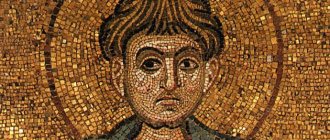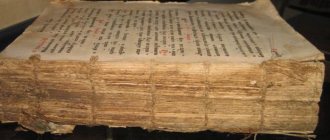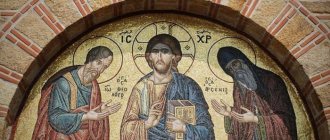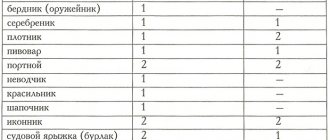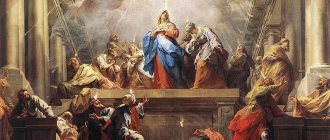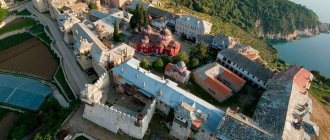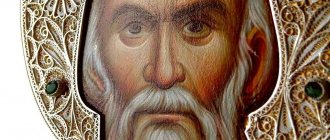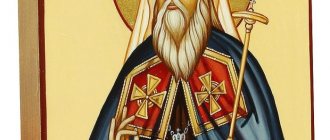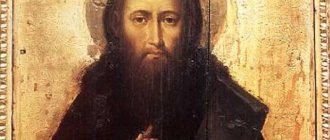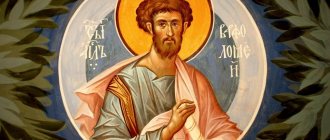The Holy Great Martyr Demetrius of Thessaloniki is revered in the Orthodox world on a par with St. George the Victorious, he is one of the most beloved warrior saints in Rus'. In Greece, St. Demetrius is considered the patron saint of Thessalonica (Thessalonica). He is often called the Myrrh-Streamer or Myrrh-Streamer (ὁ μυροβλύτης / μυροβλήτης), because his relics abundantly exuded myrrh.
Hagiographic texts often call St. Demetrius the Victorious, this is due to the fact that most of the miracles he performed were interventions in the course of military operations on the side of the Orthodox army.
Day of Remembrance
Remembrance Day is celebrated by the Church on November 8 (October 26, old style).
Great Martyr Demetrius of Thessalonica School or art. center: Mstera Second half of the 19th century. Wood, tempera. 31 × 26.5 cm Central Museum of Ancient Russian Culture and Art named after. Andrey Rublev, Moscow, Russia Inv. KP 4019
As a warrior, Saint Demetrius of Thessalonica gained special fame in Rus'.
Interesting fact
The establishment of Parental Saturday is associated with the tradition of commemorating fallen soldiers. It was established after the Battle of Kulikovo, the day began to be called Dimitrievskaya parental Saturday. Grand Duke Dimitri Donskoy believed that his heavenly patron participated in the battle on the side; there is an iconography of St. Demetrius overthrowing Mamai.
Saint Demetrius - patron saint
Saint Demetrius was invisibly the protector of his hometown of Thessalonica. Russian soldiers always believed that they were under the protection of the Great Martyr Demetrius.
The veneration of the saint in the Russian Orthodox Church began immediately after the Baptism of Rus'. And the day of his memory has always been associated with military feats and the defense of the Fatherland.
Through prayers to his heavenly patron, Dmitry Donskoy won a number of brilliant military victories. His victory on the Kulikovo Field was especially significant, after which Dmitrievskaya memorial Saturday was established - in memory of the soldiers who died in battle. Later on this day, all Orthodox Christians who have passed away from time to time will be commemorated.
“17 centuries have passed since that time. But the Church remembers her faithful sons and daughters, children of the Heavenly Father, and they testify to deep faith, devotion to the will of God and the salvation of our human souls. Demetrius of Thessalonica is the patron saint of warriors. He was a warrior himself. Therefore, he is depicted on banners and many churches, military units, and regiments are named after him. He is the patron of all youth who defend their Fatherland,” noted Metropolitan Pavel.
Life of the Great Martyr
Most likely, the biography of St. Demetrius became known in Rus' practically with the establishment of Christianity, the name of the great martyr was the baptismal name for the Grand Duke Vsevolod the Big Nest (prince of Vladimir from 1176), he also established a special veneration of St. Dmitry Solunsky. The oldest icon of the saint that has come down to us also dates back to the twelfth century.
Useful materials
“The Torment of Demetrius of Thessalonica” is a famous Greek martyrium (from the Greek “martiros” - martyr, witness), a hagiographic text, possibly written in the fifth or sixth century and very early translated into Slavic languages. It was partly reproduced in the Great Menaions of Metropolitan Macarius. In the seventeenth century, the life cycle of St. Demetrius of Thessalonica was updated in the works of his namesake, St. Demetrius of Rostov.
Thus, the Russian hagiography of the saint was based on Byzantine collections telling about the miracles of the Great Martyr Demetrius of Thessaloniki, the oldest of which belong to the pen of Archbishop John of Thessaloniki and date back to the mid-seventh century.
Saint Demetrius of Thessalonica First half of the 18th century. Wood, tempera. 35 × 26.5 cm National Museum of Przemysl, Przemysl, Poland Inv. MPH-1065 Comes from the village of Krajna in the Podkarpackie Voivodeship in Poland.
Saint Demetrius of Thessalonica was born in the Thessalonian region, at the end of the third century, into a family of secret Christians. His father was a high-ranking Roman dignitary. When he died, the position of proconsul passed to his son, who at that time was already an adult and had managed to establish himself in the service. St. Demetrius was charged with, first of all, border service, protecting city borders from external enemies.
However, this was a period of persecution of Christians, and from St. Demetrius, as the Roman proconsul, was required to support the imperial initiative. The Romans revered the gods at the state level, in particular, they deified the emperor. Very soon, Emperor Maximian Galerius was informed that the young proconsul not only did not persecute Christianity, but also openly preached, helping it to flourish in every possible way, eradicating pagan customs and leading the people to faith in Christ.
Upon returning from the Sarmatian campaign, Maximian made a stop in Thessalonica, arrested the young proconsul and decided to entertain the local community with gladiatorial fights, the unrequited victims of which were Christians. They were easily defeated by the battle-hardened warriors of the emperor, and, defeated, they were thrown onto spears.
In the dungeon of St. Dimitri began to prepare for death. He was visited by the Christian youth Nestor, who was about to fight a mighty Roman gladiator. The saint blessed Nestor and he won the fight, throwing his opponent onto his spear. As the winner of the competition, he should have been released, but this was not part of Maximian’s plans and Nestor was executed. After some time, St. was put to death. Dimitri. By order of the emperor, he was pierced with spears and his body was thrown out to be devoured by animals.
Another version of the life presents a slightly different story: the murdered gladiator was the favorite of the warlike Maximian, and Nestor said that the Roman gladiator was “killed by an angel sent by Demetrius.” This angered the emperor and he ordered the young proconsul to be put to the same death - to be pierced with spears. The Christian community secretly buried the saint's body. It is known that miracles of healing occurred from his bloody robe and ring.
Empire against the Church or Church against the Empire?
According to some researchers, religion was the only cement that could hold together the lifeless state mechanism. Hence the desire to support and establish the ancient cult of the Olympian gods, of which the emperor considered himself the high priest, and the persecution of “new and unheard of sects” who, in their “criminal darkness of mind,” want to overthrow what was given from ancient times.
Meanwhile, Christian society, taking advantage of the long-term calm after the persecution of Emperor Valerian (who, by the way, at the beginning of his reign was also quite loyal to Christians), grew, strengthened and spread throughout the empire. It was welded together by close mutual ties, maintained independence and boldly declared publicly that its faith was the only one - the true one. The Christian Church was a kind of state within a state. Without any conspiracy, she undermined the ancient imperial structure.
In this situation, the energetic and, in his own way, religious emperor had only one outcome - to enter into a fight with the Church. Which is what he did. But not at once. To begin with, he needed to strengthen the entire state machine - Christians were very numerous and influential.
Miracles
The Greek “Martyrias” tell in detail about the posthumous miracles of St. Demetrius of Thessalonica, for the most part this is the appearance of a martyr during the siege of cities, the provision of military assistance, miracles of healing. The most famous can be called the “Miracle of the Angels”, it is associated with the mission of St. Demetrius, called to the defenders of Thessaloniki.
During the siege of the city by barbarians, St. Demetrius said that two angels came to him from the Lord and conveyed the news that He no longer wanted to protect the city, in which there was a lot of sin. This news saddened the saint and he begged the angels to ask God to have mercy on Thessalonica. The next morning the city was saved, and the barbarians were put to flight.
The miracle of the death of the Bulgarian national hero - Tsar Kaloyan, who died suddenly on the eve of the assault on Thessaloniki, is one of the very characteristic episodes of the life of St. Demetrius of Thessalonica. According to legend, the saint pierced him with a spear, after which the Bulgarians fled in horror from the city walls. The iconography of the miracle of Kaloyan largely repeats the icon of St. St. George the Victorious beating the serpent.
Miracle of Demetrius of Thessalonica End of the 17th century. 37 × 34 cm Museum of Fine Arts of the Republic of Karelia, Petrozavodsk, Russia Comes from the village of Tambitsy, Medvezhyegorsk district.
Russian veneration of St. Demetrius of Thessalonica was a consequence of both the common spiritual space and everyday trade ties between Rus' and Byzantium. Confirming the continuity of Christianity from the Apostolic Byzantine Church, Russian princes were baptized with the name of Saint Demetrius, this is one of the most popular names among the Russian aristocracy.
The predominant military culture of ancient Rus' could not help but elect one of the most revered heavenly warriors as its heavenly primate. In The Tale of Bygone Years there is a somewhat boastful story about how the Greeks confused Prince Oleg with St. Demetrius of Solunsky -
“And the Greeks were afraid, and decided: behold, Oleg, but Saint Demetrius was sent to us from God.”
After Rus' was baptized, St. Demetrius quite naturally became the favorite Russian patron of Orthodox soldiers.
Persecution persecution discord
The persecution began in 303 with three imperial decrees. The first ordered the destruction of Christian churches and the burning of books, the second ordered all representatives of the Christian clergy to be imprisoned in prison, the third ordered all arrested priests to sacrifice to the pagan gods under pain of torture. And in 304, a fourth decree was issued, which gave rise to mass repressions - it ordered all Christians to make sacrifices to the pagan gods.
True, Diocletian himself carried out his decrees “without fanaticism,” but he did not rule the empire alone. Maximian, one of his co-rulers, who ruled in the west (Italy, Spain, Gaul and partly Africa), a naturally cruel man, took Diocletian’s measures to the extreme - there were many martyrs in his regions, especially in Africa. Another co-ruler, Constantius, was a gentle man, and also a religious eclectic, who preferred more or less pure monotheism to ordinary pagan superstition. Although he could not cancel Diocletian’s decrees, he did not really insist on their implementation.
The third co-ruler of the emperor, his son-in-law Galerius, who ruled in the east, about whom the Christian writer Lactantius says that “an atrocity unknown to the Romans” was noticeable in him, fell into his element: the usual executions under him were being burned, hanging on a cross, torn to pieces by beasts, and the one whose head was simply cut off considered himself lucky. And even before all the decrees, he proposed to burn all Christians alive. Galerius appointed prefects to suit himself. And Maximin, whom he chose as his assistant, was no better than his boss.
Iconography
At the end of the twelfth century, the “tomb board” of St. was brought to Vladimir from Thessalonica. Demetrius of Thessalonica, “myrrh-streaming and miraculous.” In 1380, it was moved to Moscow, has survived to this day and is kept in the local row of the iconostasis of the Assumption Cathedral of the Kremlin. Unfortunately, the original icon has not survived, and the painting on it dates back to the eighteenth century and belongs to the brush of Kirill Ulanov, master of the Armory Chamber.
Demetrius of Thessalonica Ulanov Kirill Ivanov (in monasticism - Cornelius) 1701 [board - XII century.
(?)] 169 × 86 cm Assumption Cathedral of the Moscow Kremlin, Moscow, Russia Inv. Ж-129 See in the “Gallery”: Demetrius of Thessaloniki It is known that he painted the icon in 1701, possibly over the previous image of the saint.
The renewed life-size icon represents the Great Martyr Demetrius of Thessalonica in rich military armor, with a spear and sword. Painted in the exquisite semi-Baroque style characteristic of the Armory, the painting is richly decorated with gold floats. Traditional Russian icon painting adopted St. Demetrius of Thessaloniki not only in the image of a warrior, but also as a meek martyr; if for a Byzantine icon the image of a saint with a weapon, a sword and a spear is traditional, then Russian icon painters partly rethought the image.
The famous Pskov icon of Dmitry of Thessaloniki of the fifteenth century represents the saint in red robes, symbolizing the repetition of the feat of the cross and the obligatory cross in his hand - the foreground of the icon. It is interesting that the sword seems to be hidden behind a shield, and is depicted in a very primitive way.
Dmitry Solunsky School or art. center: Pskov XIV–XVI centuries. (?) 105 × 59 cm State Russian Museum, St. Petersburg, Russia Inv. DRZh-2096 The origin of the icon has not been established. Employees of the State Russian Museum suggest that it was originally performed at the turn of the 14th and 15th centuries, and perhaps not in Rus', but subsequently, in the 16th century, it was almost written anew by the Pskov master.
The face of the Pskov icon also bears archaic features, a perspective distortion of the saint’s face, showing it as if in a dynamic turn towards the beholder and imparting some “menacingness” to the saint’s gaze. Dimitri. The color harmony of the icon, traditional for Novgorod, is composed with a predominance of red cinnabar color, this is a very energetic image.
The oldest known icon of St. Demetrius of Thessaloniki is kept in the State Tretyakov Museum, previously located in the city of Dimitrov. The customer of the icon was supposedly Prince Vsevolod the Big Nest, that is, the icon was painted before 1212.
Dmitry Solunsky on the throne School or art. center: Vladimir-Suzdal school End of the 12th century. Onasch 1961: XII century. Antonova, Mneva 1963: Second half of the 12th century. Rostov-Suzdal painting 1970: End of the 12th century. Tretyakov Gallery 1995: The end of the XII - the beginning of the XIII centuries. Lazarev 2000/1: The end of the 12th century. 156 × 108 cm State Tretyakov Gallery, Moscow, Russia Inv. 28600
The rarity of this iconography lies not only in its antiquity, it depicts St. Demetrius as a mature husband, partially in princely attire. It is believed that the icon painter endowed the great martyr with the features of a prince, emphasizing their heavenly connection (Vsevolod in baptism - Dmitry). On the princely throne there is a “tamga” depicted - the family sign of the prince, who added the words of All Rus' to his title and united the largest Russian principalities.
Relics
Already in the fourth century, during the reign of Constantine the Great, a temple was built over the grave of the Great Martyr Demetrius of Thessaloniki, and a hundred years later the incorruptible relics of the saint were found. From the seventh century, the shrine containing the relics of the saint began to stream myrrh; the myrrh had special physical properties and a fragrance emanated from it.
Around the tenth century, the cult of the relics and blood of the saint had developed. Relics of St. Demetrius of Thessalonica was considered myrrh-streaming from the most ancient times; in Russian life it is reported that cases of myrrh-streaming were recorded from the seventh century, however, there is other data about later dates. Archaeological examination attributes the surviving glass ampoules into which believers collected the myrrh that flowed in abundance from the incorruptible relics of St. Demetrius, to the ninth-twelfth century.
From time immemorial, myrrh has been revered in the Muslim tradition, which considered it a universal remedy for all diseases. There is a semi-mythological account by the twelfth-century Byzantine historian, Niketas Choniates. He conveys information about such an incredible amount of peace that came from the relics that the Normans who came to ravage Thessalonica in 1185 allegedly collected it in pots and used it for cooking and various household purposes, like ordinary oil. It is not known whether such blasphemous actions entailed any consequences for the Vikings, other than their fairly rapid Christianization.
During the Fourth Crusade, the relics of Saint Demetrius were stolen during the brief period of the existence of the Latin Kingdom of Thessalonica, and transported to Italy. They were first discovered in 1520, at the temple of the Abbey of San Lorenzo in Campo. Later, in our time, they were identified during archaeological work at the temple. In 1978, the venerable head of the great martyr, and later other particles, were solemnly returned to Greece. Currently, the relics of Dmitry of Thessaloniki are located in Thessaloniki in Greece.
The saint’s relics travel throughout the Orthodox world and are often brought to Moscow. In 2022, they visited Yekaterinburg, the Church on the Blood. Many believers were able to worship the saint. In the church of St. Demetrius of Thessalonica in Moscow, that in the village of Vostochny there is a revered icon with a reliquary of St. Dimitri.
What does a saint help with?
Traditionally, it is customary to pray to Saint Demetrius of Thessalonica when you need help in healing, especially eye diseases; strengthening of faith is required or there is not enough determination to take a bold action. They ask him for deliverance from fears; the saint’s intercession is called upon in case of danger.
Since ancient times, St. Demetrius has been considered the patron saint of the military, defenders from the enemies of Christianity. The Russian nuclear icebreaker “Dimitri of Solunsky” was consecrated in the name of the great martyr.
Author: Ksenia Filina
Interesting Facts
- The Great Martyr Demetrius of Thessalonica is revered in Orthodox and Catholic countries, and in some Christian cultures he has become the hero of legends and poetry.
- In Russia, the saint helped soldiers in battles with Temnik Mamai, and his icons have served as protection from irreconcilable enemies since ancient times.
- There is a known icon, brought to Vladimir in the 12th century, according to legend, painted by an unknown artist on a board from the tomb where the saint lay. The day of her appearance in Russia was immediately included in the calendar and was celebrated regularly by a large Orthodox country.
- In connection with the arrival of peace of mind, a holiday was organized on Demetrius' Day, which connected the great martyr with thousands of grateful hearts.
Troparion, kontakion, magnification
Troparion, tone 3:
Great will you find in troubles/ you are the champion of the universe, more passionate,/ the conquering tongues./ Just as you brought down Lieva’s pride,/ and for the feat of courage you created Ne hundred, / so, Saint Demetrius, / pray to Christ God // to grant us great mercy.
Kontakion, voice 2:
With your streams of blood, Demetrius, / God stained the Church, / giving you an invincible fortress, / and keeping your city unharmed // for this is your affirmation.
Greatness
We magnify you, passion-bearing Saint Demetrius, and honor your honest suffering, which you endured for Christ
Canon
Canon to the Great Martyr Demetrius of Thessalonica, voice 4:
Song 1
Irmos: Ancient Israel walked across the dark abyss with damp feet and defeated the power of Amalek in the desert with the cross-shaped hand of Moses.
We are crowned with divine torment, we rejoice with God, we shine with brilliance from the tedious and we fulfill enlightenment, most wonderful martyr.
As a being of the Truth, a witness, and even having labored to the point of blood, blessedly, patiently; Having shown firm resistance to the tormentor, the Lord accepts you.
You have brought down the recipient of malice to the earth, Demetrius, having killed him with your martyr's copy, with Divine goodness, more than the power of the mind, we strengthen for this, blessed one.
Theotokos: Motherless, as God is above all, who is for us the Fatherless One from You, the All-Singing Mother of God, the flesh is received by unity, more than words and reason.
Song 3
Irmos: Your Church rejoices in You, Christ, calling: You are my strength, Lord, and refuge, and confirmation.
Reckon the commandment from you to the tormentors; You have preceded the Word of God more than all others, most passion-bearing.
You were a priest of the light of torment in the tabernacle, shining with the Divine Light, the passion-bearing martyr Demetrius.
You are a holy and wondrous source of healing, having acquired your city and treasure without stealing, you have been enriched with all joy.
Theotokos: Healing the image of the decayed earthly One, the Most Pure One will clothe You with this, remaining as a Lover of Mankind.
Sedalen, voice 4:
As to the valor of the sufferer and the strong warrior of the All-Reigning Christ, we cry out in psalm: Rejoice, adornment and beauty of martyrs; Rejoice, bright star of the Church and wall and refuge of those who come running to you, glorious great martyr Demetrius, save you who sing from all foreign harm and all bitterness.
Song 4
Irmos: You are exalted, having seen the Church on the Cross, the Righteous Sun, standing in your rank, worthy of crying: glory to your power, Lord.
Having conquered the lie of wickedness, having seen the Most High God's Word, crowning you with glory, Demetrius, singing: glory to your power, Lord.
Having established victory over flattery, you accepted the victorious crown of righteousness, Demetrius, calling to your Creator: glory to your power, O Lord.
We direct our life-giving hand, to the quietest refuge you have reached, where, now rejoicing, you call to Demetrius: glory to your power, Lord.
Theotokos: As the Most Sacred of all creatures, You have been vouchsafed to be the One Mother of God; having given birth to Him, You have enlightened the world with the grace of the Knowledge of God.
Song 5
Irmos: You, Lord, my light has come into the world, Holy Light, convert those who sing of You from the darkness of ignorance to faith.
Welcome the fire of Divine love into the hearts, you extinguished the fire of godless idolatry, glorious Demetrius.
Delivering us from troubles, appearing, Demetrius, covering those who praise you with faith and love with your prayers.
Those who diligently flock to your temple with faith, Demetrius, will soon be delivered from ailments and strangled passions.
Theotokos: The Word of God, Consubstantial with the Father, is Yours, O Mother of God, more than mind and words, the Son, Consubstantial with You.
Song 6
Irmos: I will devour Thee with a voice of praise, O Lord, the Church cries out to Thee, having been cleansed of demonic blood, for the sake of mercy the Blood flowed from Thy side.
According to what has come together, we sing of your glorious and luminous memory, and full of miracles, and the gifts of the Holy and Honest, Most Blessed, Spirit.
Resolve my captive sins with your prayers, for the martyr’s boldness to the Lady is invincible, and be my refuge and protection, Demetrius.
Theotokos: You found Your purity in the midst of thorns, like the purest color and full color, O Bogomati! Bridegroom, the Word dwells in Your womb.
Kontakion, voice 2:
With streams of your blood, Demetrius, God stained the Church, giving you an invincible fortress and keeping your city unharmed; That is why you are a statement.
Ikos
Let us all sing of this great one, having come together in faith, as the armorer of Christ and the martyr, Demetrius, in songs and singing we call upon the Lady and Creator of the universe: deliver us from cowardice and need, Lover of mankind, through the prayers of the Mother of God and all your holy martyrs. We all hope in You to get rid of troubles and sorrows, for You are our affirmation.
Song 7
Irmos: In the cave of Abraham, the Persian youths, with the love of piety more than being scorched by flame, cried out: Blessed are you in the temple of Your glory, O Lord.
Adorned with Divine glory and grace, O passion-bearing martyr, you shine radiantly and enlighten those who call: blessed art thou in the temple of Thy glory, O Lord.
Like scarlet, adorned with your blood, having instead of a scepter, gloriously, a cross; Thou art now reigning with Christ, martyr Demetrius, blessed art thou, the caller, in the temple of Thy glory, O Lord.
Theotokos: Most Glorified, Enlightened, Mother of the Virgin, protect all who honor Thee, the All-True Mother of God; Blessed are You among women, O All-Immaculate Lady.
Song 8
Irmos: Daniel stretched out his hand, the gaping lions in the ditch were imprisoned: having quenched the fiery power, girded with virtue, the zealous youths of piety, crying out: bless all the works of the Lord the Lord.
Thou hast darkened all the enemy's wrath, gloriously, and, having been clothed with the inalienable power of Christ in the struggle, and having become a victor, the martyr Demetrius, thou cried out: bless all the works of the Lord the Lord.
Having shown the prosperity of the martyrs, the blessing of the martyrs, martyr, you have inherited; Having washed ourselves in the holy bath, even the second is not defiled by sinful pretexts, we pierce it with a spear, and call: bless all the works of the Lord the Lord.
Your miracles are many, more than the talents of the mind, which Christ gave you, he shows everyone, gloriously, and the grace of healing, even more than words, your grace preaches to us, crying out: bless all the works of the Lord the Lord.
Theotokos: One in all generations, the Virgin Mother and the Pure Mother of God, let us hymn: She who is the Intercessor of our salvation, as the Deliverer of the world, gave birth to the Word, to whom we cry: bless all the works of the Lord the Lord.
Song 9
Irmos: The uncut stone from the uncut mountain, to You, Virgin, the cornerstone was cut off, Christ, who united the dispersed nature; Thus, having fun, we magnify You, Mother of God.
Break the bonds of the sins of those who sing, more passion-bearing, set aside the excuses of passions, destroy the rumors of heresies and misfortunes, calm the storm with your prayers.
Direct your most sacred flock to the right paths of the Heavenly Kingdom, crowned martyr Demetrius, to saving pasture, to an eternal place.
May the crowns of glory and the Heavenly Kingdom be received by those who sing this, pray to thee, Martyr Demetrius, Life-Giver of the Lord and King of Powers.
Theotokos: As the root, the source and the guilt of incorruption, You, the Virgin, are all faithful, hoping, we honor with praises; You have exuded the Hypostasis of Immortality for us.
Svetilen
You armed Nestor with the cross, through it you destroyed Leah’s pride, Demetrius, at the tributary, like Christ, you opened your side with a spear, in the image of your flock you guard.
Prayer to the Great Martyr Demetrius of Thessalonica
Holy and glorious Great Martyr of Christ Demetrius, quick helper and warm intercessor of those who flow to you with faith! Standing boldly before the Heavenly King, ask Him for forgiveness of our sins and to free us from the all-destroying plague, cowardice, flood, fire, sword and eternal punishment. Pray for His goodness to show mercy to this city, this monastery and every Christian country. Seek from the King of the Reigns victory and victory over the enemies of the Orthodox Christians, the entire Orthodox Empire for peace, silence, firmness in faith and advancement in piety; for us, who honor your honorable memory, ask for grace-filled strengthening for good deeds, so that our Lord Christ God works here with grace, we may be worthy through your prayers to inherit the Kingdom of Heaven for His eternal glorification with the Father and the Holy Spirit. Amen.
( 3 ratings, average: 5.00 out of 5)
